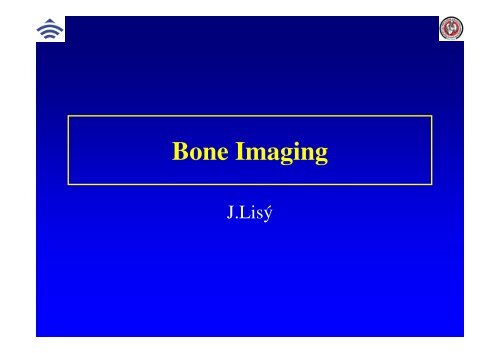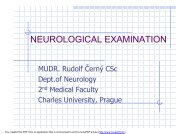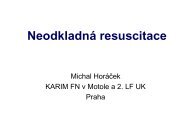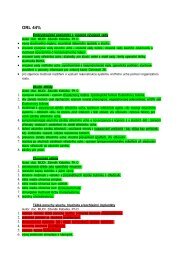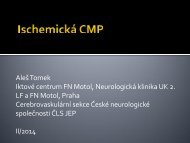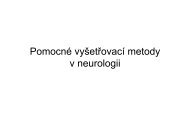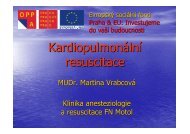Bone Imaging
Bone Imaging
Bone Imaging
Create successful ePaper yourself
Turn your PDF publications into a flip-book with our unique Google optimized e-Paper software.
<strong>Bone</strong> <strong>Imaging</strong><br />
J.Lisý
• Diaphysis<br />
• Metaphysis<br />
Anatomy – long bones<br />
• Zone of provisional<br />
calcification<br />
• Epiphyseal growth<br />
plate<br />
• Epiphysis
Anatomy – long bones<br />
epiphysis<br />
metaphysis<br />
diaphysis<br />
growth<br />
(epiphyseal)<br />
plate<br />
zone of provisional<br />
calcification
Epiphysis<br />
Epiphysis x Apophysis<br />
•articulates with adjacent bone<br />
Apophysis<br />
•doesn´t articulate with<br />
adjacent bone<br />
Epiphyseal or apophyseal plate should not be mistaken as fracture lines
• focal decalcination<br />
decreased attenuation<br />
lucency (dark bone)<br />
• marginal osteolysis<br />
usuration, erosion<br />
Osteolysis
• focally increased<br />
attenuation<br />
(white bone)<br />
Osteosclerosis<br />
chron. OM osteopetrosis
• less dense bone<br />
• loss of organic and<br />
anorganic bone<br />
• darker, lucent bone<br />
• compact, cortical bone<br />
thinner<br />
• white rim around bone<br />
Osteoporosis
Osteomalacia<br />
• reduced anorganic portion<br />
• darker bone<br />
• loss of cortical compact<br />
bone<br />
• Ill defined, hazy contours<br />
rachitis
periosteum is not<br />
normally seen<br />
1) Spiculoid<br />
2) Lamellar<br />
3) Codman´s<br />
triangle<br />
Periostal reaction
Developmental dysplasia of the hip<br />
• orthopaedic examination<br />
and ultrasound<br />
• pathological finding is<br />
indication for X-ray<br />
investigation<br />
1) osification of femoral head<br />
2) course of the acetabulum<br />
3) position of the hip joint
Developmental dysplasia of the hip US<br />
Ultrasound<br />
alpha angle<br />
• the slope of the superior<br />
aspect of the bony acetabulum<br />
(normal greater than 60º)<br />
beta angle<br />
• depicts the cartilaginous<br />
component of the acetabulum<br />
(normal if less than 55º)<br />
evidence is insufficient to recommend routine screening for dev.<br />
dyspl. of the hip in infants as a means to prevent adverse outcome<br />
(U.S. Preventive Services Task Force, 2006)
Developmental dysplasia of the hip X-rays<br />
X-rays<br />
1) osification of femoral head<br />
2) course of the acetabulum<br />
3) position of the hip joint
Craniosynostosis<br />
• premature closure of the<br />
cranial sutures<br />
• involved suture is narrow<br />
or is not visible<br />
• lacunar skull (expressive<br />
impresiones of brain gyri<br />
on the inner table of skull)<br />
Scaphocephalia<br />
brachicephalia<br />
Turicephalia
Osteogenesis imperfecta<br />
• congenital fragilitas<br />
ossium<br />
• deficient formation of<br />
bone matrix and collagen<br />
• repeated fractures of<br />
different age<br />
• bizare deformities<br />
• bowed bones, extremities<br />
shorter, cortex thin
Osteopetrosis (Albers-Schonberg)<br />
• failure of normal resorption<br />
of calcified chondral tissue<br />
• osteosclerosis<br />
• bottle-shaped metaphyses<br />
• sandwich vertebra<br />
• pathological fractures
Mucopolysacharidosis<br />
Gargoylismus (Hurler´s type )<br />
palm-leaf-shaped ribs<br />
maldevelopment of upper half of<br />
vertebral body (upside down parrot<br />
beak shaped )<br />
coxa valga
M. Perthes<br />
• most frequent aseptic necrosis<br />
• etiology unknown<br />
• head and neck of the femur<br />
• 5 th -10 th year of age<br />
• X ray signs delayed 6 weeks after<br />
clinical symptoms<br />
• bones shorter, unhomogeneous<br />
with foci osteosclerosis and<br />
osteoporosis<br />
• later fragmentation and deformity
Other aseptic necrosis<br />
• Osgood-Schlatter<br />
(tuberositas of tibia)<br />
• Blount<br />
(med. condyle<br />
-tibia vara)<br />
• Koehler I<br />
(naviculare pedis)<br />
• Koehler II<br />
(head of MTT II)<br />
• Haglund<br />
(calcaneus)<br />
• Kienbock<br />
(lunatum)
Scheuermann´s disease<br />
(juvenile vertebral epiphysitis )<br />
etiology unknown<br />
around puberty<br />
Th spine<br />
• expressive kyphosis<br />
• wedge- shaped<br />
vertebral body<br />
• irregular margin of<br />
the vertebral body<br />
• Schmorl´s nodules
• acute x chronic<br />
• specific x unspecific<br />
Osteomyelitis acute<br />
• X-ray changes delayed<br />
10 to 20 days<br />
• soft tissue swelling<br />
• bone destruction<br />
• erosion
Osteomyelitis chronic<br />
• periosteal reaction<br />
• irregular sclerotisation<br />
• sequestration, involucrum<br />
Brodie´s abscess<br />
• metaphysis of the long<br />
bones (most frequent<br />
femur)<br />
• circumscribed osteolytic<br />
area with sclerotic margin<br />
www.radiopedia.org
Osteomyelitis sclerotisans Garré<br />
• unpyogenic<br />
• osteosclerosis<br />
• spindle-like diaphyseal<br />
enlargement
Tuberculous spondylodiscitis<br />
• specific<br />
• early destruction of disc<br />
(lower intervertebral space)<br />
• later infection crosses<br />
vertebral endplates<br />
(higher intervertebral space)<br />
• complications<br />
paravertebral/epidural<br />
abscess
Congenital syphylis ( lues )<br />
• diaphysitis<br />
• metaphysitis (Wegener´s<br />
zone )<br />
• periostitis<br />
Wimberger´s sign:<br />
erosions at the medial<br />
portion of the proximal<br />
metaphysis
Rachitis (rickets) avitaminosis D<br />
Osteomalacia ( bone<br />
substituted by osteoid)<br />
• unsharp margins<br />
• tumbler-like deformity of<br />
metaphyses<br />
• rachitic rosary on the ribs<br />
Healing:<br />
• periostosis<br />
• doubled zone of the<br />
provisional calcification
Scorbut (scurvy) avitaminosis C<br />
• Subperiosteal hematomas<br />
• Multiple epifyzeolysis<br />
Pelkan´s sign :<br />
sharp metaphyseal margins<br />
Winberger´s sign :<br />
sclerotic rim around porotic<br />
epiphysis
Degeneration 1 st grade<br />
• most common bone involvement<br />
• sharper margins of articular surface
• osteophytes<br />
Degeneration 2 nd grade
Degeneration 3 rd grade<br />
• subchondral sclerosis<br />
• subchondral pseudocysts<br />
• narrow articular space<br />
• periarticular calcifications
• bone necrosis<br />
• (sub)luxation<br />
Degeneration 4 th grade
Bekhterev´s disease (spondylitis ankylosans)<br />
1.Sacroiliac joints<br />
• subchondral osteoporosis<br />
• subchondral erosions (rosary<br />
sign)<br />
• ankylosis
Bekhterev´s disease (spondylitis ankylosans)<br />
2. spine thoracic<br />
• rigid<br />
• marked kyphosis<br />
• bamboo stick
Paget´s disease (osteitis deformans)<br />
• enlargement of the bone<br />
• deformity (bone is bowed)<br />
• pathological fractures<br />
• osteosclerosis and osteoporosis<br />
• malignant degeneration is a<br />
serious, but infrequent<br />
complication
<strong>Bone</strong> cyst<br />
• lucent focus within bone with<br />
an expansion effect<br />
• cortex can be thin
• in metaphyses<br />
Non-osifying fibroma<br />
• eccentrical subcortical<br />
• occasionally multilocular
Osteochondroma (cortical exostosis)<br />
• bone exostosis<br />
• always from<br />
metaphysis toward<br />
diaphysis<br />
• cartilaginous cup<br />
not visible
• bone only<br />
• round shaped shadow<br />
• sharp margins<br />
• paranasal sinuses<br />
Osteoma
Enchondroma<br />
• from chondral tissue (cartilage X ray lucent, invisible<br />
• defect in bone, often expansion effect, thin and perforated<br />
cortical contour<br />
• m. Ollier multiple chondromatosis of the bones
Osteoid osteoma<br />
• diaphysis lower limbs<br />
• osteoplastic changes<br />
• nidus ( detectable CT ) round<br />
osteolytic lesion with small<br />
calcification
Histiocytosis from Langerhans cells<br />
• Eosinophilic granuloma<br />
sharp demarcated osteolytic<br />
defect<br />
• Hand-Schuller-<br />
Christian - map skull
• osteolytic/ osteoplastic<br />
• periostal reaction<br />
laminated, onion-skin<br />
spicular (Sharpey ligg.)<br />
Codman´s triangle<br />
Osteosarcoma
Osteosarcoma MRI<br />
• soft tissue part of the tumor - regression after<br />
chemo/radio therapy
Ewing sarcoma
• The next four tumors<br />
comprise 80% of all<br />
metastases to bone<br />
– Breast (70% of bone<br />
mets in women)<br />
– Prostate (60% of all<br />
bone mets in men)<br />
– Kidney<br />
– Lung<br />
• osteolytic (kidney, lung)<br />
• osteoplastic (prostate)<br />
• mixed (breast)<br />
Metastases
• most common malignant bone<br />
tumors<br />
• most involve axial skeleton<br />
(skull, spine and pelvis)<br />
where red bone marrow is found<br />
• 90% of skeletal mets are<br />
multiple<br />
• Spinal mets destroy posterior<br />
vertebral body including pedicle<br />
pedicle-sign
Skull<br />
diploe<br />
Metastases neuroblastoma


